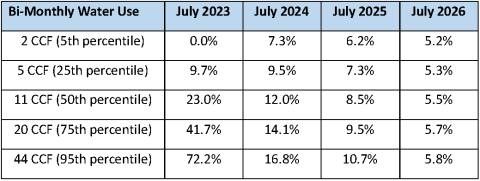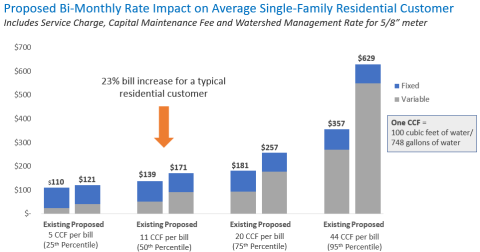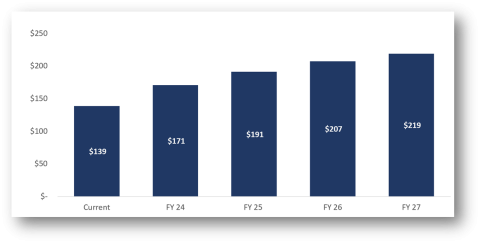New Four-Year Schedule of Water Rates, Fees & Charges took effect July 1, 2023
Under the adopted schedule, increases become effective each July 1 in 2023, 2024, 2025 and 2026. Scheduled increases will first be reflected on bi-monthly billings issued in September and October of each of those four years.
Following a public hearing on Tuesday, May 16, the Marin Water Board of Directors approved a new schedule of changes to customer water rates, fees and charges covering the next four fiscal years. The first increase of the four year schedule took effect July 1, 2023, and those changes were first reflected on customer bimonthly billings issued in September and October of 2023. Under the adopted four-year schedule, additional increases take effect each July 1 in 2024, 2025, and 2026, and will first be reflected on customer bi-monthly billings issued in September and October of each of these years.
The impact of the increase on individual customer bills varies and is dependent on the size of each customer’s meter and the amount of water used in a two-month period. Discount programs remain available to customers most in need of help with paying their water bill – these offerings include income-based waivers and medical disability discounts.
The rate changes were developed through a cost of service analysis prepared by an experienced independent rate consultant. As part of the rate setting process, Marin Water also held multiple public meetings and public workshops to explain the cost-of-service analysis, factors being considered in the assessment of the District’s revenue needs, and the rate setting process, including legal requirements. A special notice was also mailed to all water customers and parcel owners within Marin Water’s service area setting forth details of the rate proposal and scheduled public hearing on the rate adoption.
Quick links to related resources
The first increase of the four-year adopted rate schedule will take effect July 1, 2023. Revenues collected from the new fee schedule will help to:
- Strengthen water supply resiliency in the face of climate change
- Replace and modernize aging infrastructure
- Accelerate mitigation work to reduce wildfire risk and enhance forest health restoration efforts on the Mt. Tam Watershed, which is the primary source of our water supply
- Keep pace with inflation and the rising costs of operating and capital expenses
- Replenish reserves to prepare for future emergencies
Previous Informational Materials from the Six-Month Rate Development Process
Rate Proposal
Working with an independent water rate consultant to determine how best to recover its projected costs over the next four-year period, Marin Water has developed proposed rates, fees and charges that would become effective July 1, 2023, 2024, 2025 and 2026 and vary by customer class. The proposal includes:
- Changes to some customer rate tiers that will encourage conservation and allows customers greater control of their water bills
- Conversion of the Watershed Management Fee to a volumetric rate that will help reduce fixed fees for most customers
- Establishment of drought surcharges, which would go into effect only if water supply drops to critical levels and would help keep Marin Water financially stable in the event of a water shortage
Further explanation of the proposal, as well as the current and proposed service rates, fees and charges for each customer class are shown in the formal rate proposal linked below.
Ensuring 24/7 on-demand water service for you
More than 191,000 community members depend on Marin Water to provide clean, reliable water every day. It’s a mission we have carried out with pride for more than 110 years, and we do so while charging only enough to recover the costs associated with providing your water service, which includes maintenance of a complex water system and protection of 22,000 acres of watershed lands.
Marin Water continually evaluates its infrastructure needs, programs, operations and maintenance costs. Looking ahead, we face numerous challenges in working to provide reliable, high-quality on-demand water for customers. Aging infrastructure, some of it more than 100 years old, needs ongoing replacement and modernization. Strengthening the resilience of our water supply is critical to withstanding future periods of intense drought brought on by the impacts of climate change. Expansion of our work on the watershed to reduce the risk of catastrophic wildfire and protection of the ecological health of the Mt. Tam watershed will be vital to the dependability of your water. And as we work to maintain and enhance infrastructure, water supply and the watershed, we confront rising costs due to inflationary pressures and reduced revenues due to sustained periods of drought. These hurdles impact our ability to recover the costs of operating your water service.
Marin Water stands ready to confront these challenges and has taken critical steps to be well-positioned to invest in our community’s water future. Among these actions includes a recently completed yearlong Strategic Water Supply Assessment. This effort culminated with the adoption of a water supply roadmap that outlines near-term capital projects that will increase water supply availability within the next few years while also continuing to develop longer-term water supply options. Marin Water’s proposed rate increase will fund investment in these new water supply projects. It will also allow for completion of deferred infrastructure maintenance projects and fund additional system improvements, expand fire fuel reduction work on the watershed, and ensure a financially sustainable operation now and for the future. We are very proud of the vital service we provide to our community and look forward to continuing to serve you.
Cost of Service Analysis
Water rates, fees and are charges are established to recover costs included in Marin Water’s operating and capital budgets, meet the agency’s policy goals and comply with applicable law, including Proposition 218. Rates also enhance Marin Water’s ability to provide safe, reliable, and sufficient water supply to its customers over the long term. To ensure that water rates, fees and charges are established in accordance with municipal water rate setting principles and in compliance with applicable law, in 2022, Marin Water hired an independent water rate consultant to determine how best to recover projected costs over the next four-year period through a Cost of Service Analysis.
Bi-Monthly Rate Impact on the Average Single-Family Residential Customer
A majority of Marin Water single family residential customers use a 5/8” size water meter and average about 11 CCFs (8,228 gallons) of water per bi-monthly billing cycle. Applying those circumstances in the chart below, the estimated changes resulting from the rate increase for a typical residential customer over the four-year rate schedule are shown. Download and use the rate calculator tool for the most accurate estimate of what your household's new bill amount would be funder the rate proposal -- refer to your water bill if you are unsure of your household's water use and meter size.
Typical Single Family Customer - 11 CCF (8,228 gallons) Bi-Monthly |
Charge | Current | Proposed
July 1, 2023 | Proposed
July 1, 2024 | Proposed
July 1, 2025 | Proposed
July 1, 2026 |
Tier 1 Water Use | $52.03 | $84.37 | $100.76 | $112.64 | $119.46 |
Watershed Management Rate | $11.59 | $6.71 | $6.82 | $7.04 | $7.26 |
Service Charge | $44.62 | $48.04 | $50.44 | $52.96 | $55.61 |
Capital Maintenance Fee | $30.42 | $31.50 | $33.08 | $34.73 | $36.47 |
Bi- Monthly Bill Total: | $138.66 | $170.62 | $191.10 | $207.37 | $218.80 |
| Increase to bi-monthly bill: | | $31.96 | $20.48 | $16.27 | $11.43 |
Monthly increase: | | $15.98 | $10.24 | $8.13 | $5.71 |
Rate Calculator (for single family residential and duplex customers)
The above charts illustrate the proposed rate impacts on customer bills for the average Marin Water customer who uses a 5/8” meter and 11 CCFs of water every two months. If your residential water meter is larger than 5/8”, you use more or less than 11 CCFs of water bi-monthly and/or you qualify for customer discount programs, please use our rate calculator to help you determine what your estimated water bill amount would be under the proposal.
Customer Discount Programs
Marin Water maintains a number of programs designed to save qualifying customers money on their water bills. Whether Marin Water customers have a medical condition that requires additional water or are struggling to make ends meet amid inflation and other economic concerns, Marin Water offers a variety of discounts to eligible ratepayers.
Frequently Asked Questions
Public Meetings & Engagement
The rate setting process began in winter 2022 and development of a proposal continued through spring 2023. During this time, there have been eight public meetings of the Board of Directors to discuss and provide direction to staff on the development of various elements of the proposal and receive public comments.
Additionally, Marin Water staff hosted four customer workshops in February to meet with community members to share preliminary rate proposal options, gather feedback and answer questions.
Formal notices detailing the finalized rate proposal were mailed to all customers and property owners in Marin Water’s service area in late March 2023. The mailer also notifies customers of how to protest the rate proposal as we as information on the rate-setting Public Hearing scheduled for Tuesday, May 16, 2023, beginning at 6:30 p.m.
Review past rate-setting process meeting materials below.
BOARD AND COMMITTEE MEETINGS
May 16, 2023 - Board of Directors Meeting
Agenda Item 5 - Conduct a Public Hearing on the Proposed Increases to Customer Water Service Rates, Fees and Charges; and, Adopt Ordinance No. 464 Amending Title 6 Pertaining to the Water Service Rates and Charges of the Marin Municipal Water District Code
Watch meeting recording and view documents
May 2, 2023 - Board of Directors Meeting
Agenda Item 6 - FY 2023/24 – FY 2024/25 Budget Study Session
Watch meeting recording and view documents
March 14, 2023 - Board of Directors Meeting
Agenda Item 1 - Rate Setting Process Update: Proposed Rate Structure
Watch meeting recording and view documents
Feb. 23, 2023 - Finance & Administration Committee/Board of Directors
Agenda Item 5 - Rate Setting Process Update: Revenue Requirements
Watch meeting recording and view documents
Feb. 21, 2023 - Board of Directors Meeting
Agenda Item 12 - Rate Setting Process Update: Recap of Customer Workshops, Temporary Drought Surcharges
Watch meeting recording and view documents
Feb. 7, 2023 - Board of Directors Meeting
Agenda Item 9 - Rate Setting Process Update: Review of rate-setting process, current rate structure, proposed rate plan options, proposal impacts, current cost management efforts, customer financial assistance programs, proposal benefits
Watch meeting recording and view documents
Jan. 26, 2023 - Finance & Administration Committee/Board of Directors
Agenda Item 5 - Rate Setting Process Update: Review of revenue requirements and reserve replenishment targets
Watch meeting recording and view documents
Jan. 3, 2023 - Board of Directors
Item 13: Rate Setting Process Update: Reserve and capital investment funding targets, review of District’s rates history
Watch meeting recording and view documents
Dec. 22, 2022 - Finance & Administration Committee/Board of Directors
Agenda Item 3: Rate Setting Process Update: Initial evaluation of existing rate structure
Watch meeting recording and view documents
Dec. 12, 2022 - Finance & Administration Committee/Board of Directors
Item 1: Initial Review of Cost-of-Service Analysis including updated projections and capital infrastructure funding challenges, overview of rate setting outreach plan
Watch meeting recording and view documents
CUSTOMER WORKSHOPS
Marin Water hosted one virtual and three in-person customer workshops in February. The same information was provided at each workshop, and they were scheduled for various dates and locations throughout the service area to provide multiple opportunities for customers to attend.
Workshop Presentation (Feb. 2023) | Workshop video recording (Feb. 16, 2023)
- February 16, 2023 - Virtual Zoom Meeting
- February 15, 2023 - Albert J. Boro Community Center - 50 Canal Street, San Rafael
- February 13, 2023 - Corte Madera Community Center - 498 Tamalpais Drive, Corte Madera
- February 9, 2023 - Mill Valley community Center - 180 Camino Alto, Mill Valley
Understand Your Current Water Bill
Quick link resources:
 Translate
Translate


